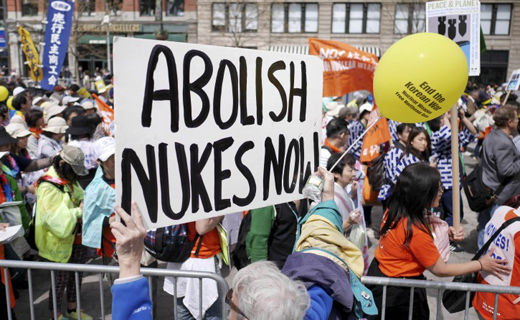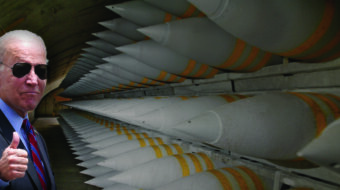
Seventy years after the U.S. dropped atomic bombs on Hiroshima and Nagasaki, 45 years after the Nuclear Non-Proliferation Treaty (NPT) entered into force and 20 years after the NPT was extended indefinitely, it’s time and past time to look at the status of efforts to rid the world of what’s been called the only true weapon of mass destruction.
And it’s vital to see the relationship between the NPT’s provisions and the new nuclear arms agreement with Iran, now the subject of sharp debate in Congress.
Under the NPT, the five acknowledged nuclear weapons states – the U.S., Russian Federation, United Kingdom, France, and China – agreed not to transfer nuclear weapons, other nuclear explosive devices, or their technology to any non-nuclear-weapon state.
They also agreed to “pursue negotiations in good faith on effective measures relating to cessation of the nuclear arms race at an early date and to nuclear disarmament, and on a treaty on general and complete disarmament under strict and effective international control.”
Unfortunately, we have yet to see much progress toward “general and complete” nuclear disarmament – the only secure way to rid the world of a scourge which could quickly end life on earth as we know it.
Nearly all nations have signed the NPT. Only Israel, India, Pakistan and South Sudan have never signed it, and North Korea withdrew from the treaty in 2003. Pakistan and India acknowledge their nuclear weapons; Israel does not, although it is estimated to have over 200 weapons in its arsenal. There are no signs that South Sudan, which just became an independent nation in 2011, has or plans to develop nuclear weapons.
In 1995, over 170 countries meeting at the Review and Extension Conference extended the NPT indefinitely, outlined next steps to implement the pact, and decided to hold review conferences every five years.
Meanwhile, non-nuclear nations, especially in the developing world, have often been sharp in their criticism of the five major nuclear powers who have signed the NPT, and especially the U.S., for failing to lead negotiations for total abolition.
Participants in the most recent NPT review conference, held April 27-May 22 in New York City, were unable to agree on a consensus document. A major issue was support the U.S., United Kingdom and Canada gave to the objections of the Israeli government – which hasn’t signed the NPT – to scheduling a conference on a Middle East zone free of nuclear or other mass destruction weapons.
Planning for such a conference should have had the enthusiastic support of all four governments, as well as every country in the world.
A number of nuclear free zone agreements have already been concluded, in Latin America and the Caribbean, Africa, Central Asia, Southeast Asia, the South Pacific and Antarctica.
A Middle East Nuclear Weapon Free Zone could be a very big step toward achieving real security for all the countries in the area, and could make it easier to reach peaceful, diplomatic resolution of other conflicts in a very troubled region.
Overlooked in the often contentious debate over the nuclear agreement with Iran is that Iran itself has long advocated such a zone in the Middle East.
Writing July 31 in the British publication The Guardian, Iranian Foreign Minister Javad Zarif called the new agreement “not a ceiling but a solid foundation on which we must build.”
Noting that the accord “cements Iran’s status as a zone free of nuclear weapons,” Zarif said it is time to expand that zone to cover the entire Middle East.
He said Iran’s proposal is supported by “some of its Arab friends in the Middle East,” but called Israel “the holdout,” a situation he said must be addressed directly.
Challenging the concept that “mutually assured destruction” could bring stability and nonproliferation, Zarif called that doctrine “the primary driving force behind the temptation by some countries to acquire nuclear weapons, and by others to engage in expanding and beefing up the strength of their nuclear arsenals.”
Zarif called starting talks for a treaty with “robust monitoring and compliance-verification” a step in the right direction.
It would seem obvious that such a treaty would not only reassure neighboring countries about Iran, it would also be one more significant step on the way toward worldwide abolition of nuclear weapons.
Active proposals date back to 1974, when Iran and Egypt jointly proposed setting up a Middle East nuclear weapon free zone in a resolution in the UN General Assembly.
Since 1980 the General Assembly has passed the resolution each year, without debate. Starting in 1991 the International Atomic Energy Agency (IAEA) has lent its support as well.
The IAEA envisions a zone extending from Libya in the west to Iran in the east, and from Syria in the north to Yemen in the south – a region now one of the world’s most conflict-ridden areas.
Adding the Middle East to the list of nuclear weapon free zone agreements around the world should help greatly to set the stage for successful negotiations to rid the world entirely of these potentially catastrophic weapons.
Photo: People participate in an anti-nuclear rally in Union Square in New York, Sunday, April 26, 2015. | Seth Wenig/AP

MOST POPULAR TODAY

‘Warning! This product supports genocide’: Michigan group aims to educate consumers

Hold the communism, please: SFMOMA’s Diego Rivera exhibit downplays artist’s radical politics

“Trail of Tears Walk” commemorates Native Americans’ forced removal

After months of denial, U.S. admits to running Ukraine biolabs

Ohio: Franklin County treasurer attends Netanyahu meeting, steps up Israel Bond purchases






Comments